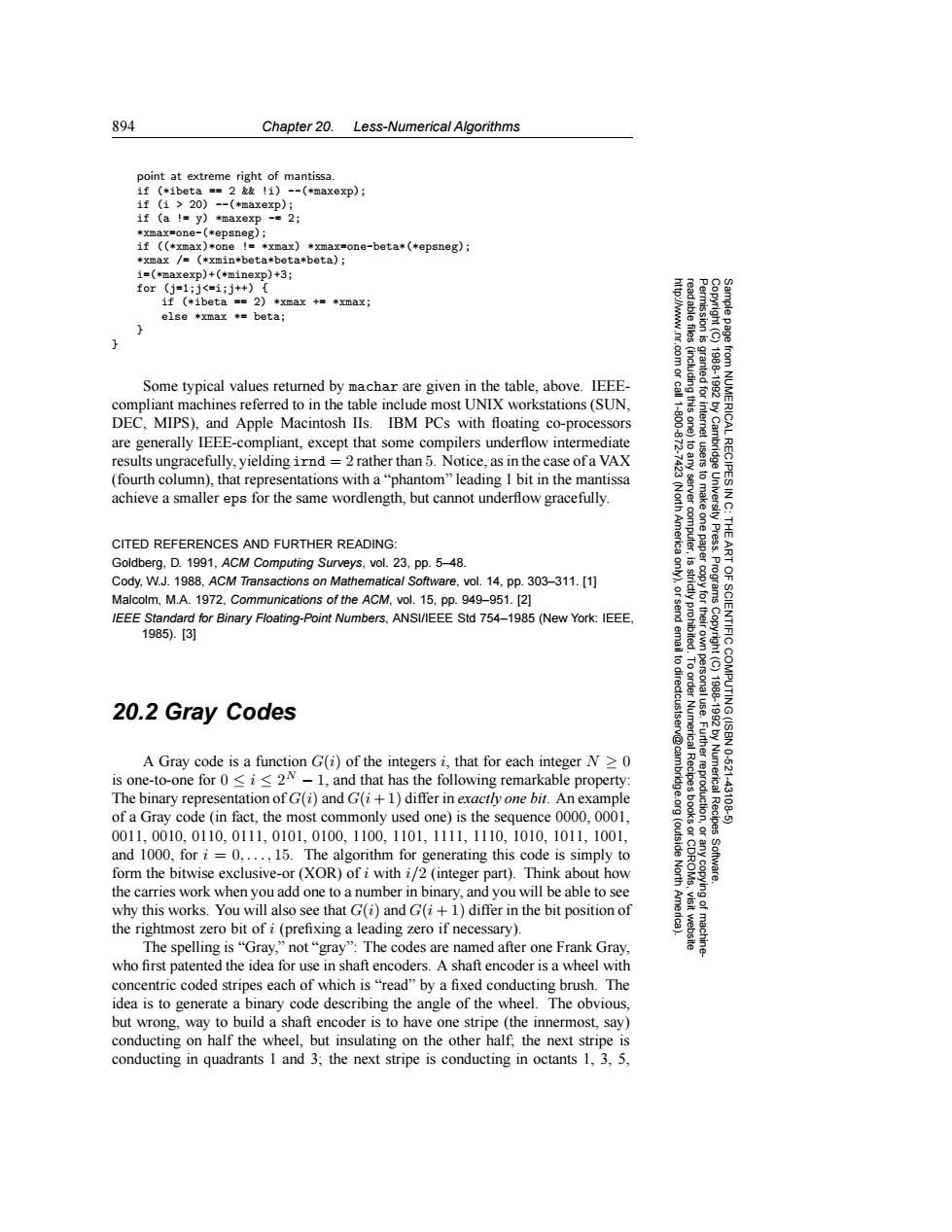正在加载图片...

894 Chapter 20.Less-Numerical Algorithms point at extreme right of mantissa. if (*ibeta ==2&li)--(*maxexp); 1f(1>20) --(*maxexp) if (a !y)*maxexp -=2 *xmax=one-(*epsneg); if ((*xmax)*one !*xmax)*xmax=one-beta*(tepsneg); *xmax /(*xmin*beta*beta*beta); i=(*maxexp)+(*minexp)+3; for(j=1;j<=1;j++){ if (*ibeta ==2)*xmax +*xmax; els日*xmax*=beta; 83 Some typical values returned by machar are given in the table,above.IEEE- 鱼 18881892 compliant machines referred to in the table include most UNIX workstations(SUN, DEC,MIPS),and Apple Macintosh IIs.IBM PCs with floating co-processors are generally IEEE-compliant,except that some compilers underflow intermediate results ungracefully,yielding irnd =2 rather than 5.Notice,as in the case of a VAX from NUMERICAL RECIPES I (fourth column),that representations with a"phantom"leading I bit in the mantissa achieve a smaller eps for the same wordlength,but cannot underflow gracefully. CITED REFERENCES AND FURTHER READING: 、门 Press. Goldberg,D.1991,ACM Computing Surveys,vol.23,pp.5-48. Cody,W.J.1988,ACM Transactions on Mathematical Software,vol.14,pp.303-311.[1] Malcolm,M.A.1972,Communications of the ACM,vol.15,pp.949-951.[2] IEEE Standard for Binary Floating-Point Numbers,ANSI/IEEE Std 754-1985(New York:IEEE 1985).[3] 、学爱 SCIENTIFIC 20.2 Gray Codes A Gray code is a function G(i)of the integers i,that for each integer N>0 G Numerical Recipes 10621 is one-to-one for 0<i<2N-1,and that has the following remarkable property: The binary representation of G(i)and G(i+1)differ in exactly one bit.An example 43106 of a Gray code (in fact,the most commonly used one)is the sequence 0000.0001 0011,0010,0110.0111,0101,0100.1100,1101.1111,1110,1010.1011,1001 and 1000,fori=0,...,15.The algorithm for generating this code is simply to (outside form the bitwise exclusive-or(XOR)of i with i/2 (integer part).Think about how North the carries work when you add one to a number in binary,and you will be able to see why this works.You will also see that G(i)and G(i+1)differ in the bit position of the rightmost zero bit of i(prefixing a leading zero if necessary). The spelling is "Gray,"not"gray:The codes are named after one Frank Gray, who first patented the idea for use in shaft encoders.A shaft encoder is a wheel with concentric coded stripes each of which is"read"by a fixed conducting brush.The idea is to generate a binary code describing the angle of the wheel.The obvious, but wrong,way to build a shaft encoder is to have one stripe (the innermost,say) conducting on half the wheel,but insulating on the other half,the next stripe is conducting in quadrants I and 3;the next stripe is conducting in octants 1,3,5,894 Chapter 20. Less-Numerical Algorithms Permission is granted for internet users to make one paper copy for their own personal use. Further reproduction, or any copyin Copyright (C) 1988-1992 by Cambridge University Press. Programs Copyright (C) 1988-1992 by Numerical Recipes Software. Sample page from NUMERICAL RECIPES IN C: THE ART OF SCIENTIFIC COMPUTING (ISBN 0-521-43108-5) g of machinereadable files (including this one) to any server computer, is strictly prohibited. To order Numerical Recipes books or CDROMs, visit website http://www.nr.com or call 1-800-872-7423 (North America only), or send email to directcustserv@cambridge.org (outside North America). point at extreme right of mantissa. if (*ibeta == 2 && !i) --(*maxexp); if (i > 20) --(*maxexp); if (a != y) *maxexp -= 2; *xmax=one-(*epsneg); if ((*xmax)*one != *xmax) *xmax=one-beta*(*epsneg); *xmax /= (*xmin*beta*beta*beta); i=(*maxexp)+(*minexp)+3; for (j=1;j<=i;j++) { if (*ibeta == 2) *xmax += *xmax; else *xmax *= beta; } } Some typical values returned by machar are given in the table, above. IEEEcompliant machines referred to in the table include most UNIX workstations (SUN, DEC, MIPS), and Apple Macintosh IIs. IBM PCs with floating co-processors are generally IEEE-compliant, except that some compilers underflow intermediate results ungracefully, yielding irnd = 2 rather than 5. Notice, as in the case of a VAX (fourth column), that representations with a “phantom” leading 1 bit in the mantissa achieve a smaller eps for the same wordlength, but cannot underflow gracefully. CITED REFERENCES AND FURTHER READING: Goldberg, D. 1991, ACM Computing Surveys, vol. 23, pp. 5–48. Cody, W.J. 1988, ACM Transactions on Mathematical Software, vol. 14, pp. 303–311. [1] Malcolm, M.A. 1972, Communications of the ACM, vol. 15, pp. 949–951. [2] IEEE Standard for Binary Floating-Point Numbers, ANSI/IEEE Std 754–1985 (New York: IEEE, 1985). [3] 20.2 Gray Codes A Gray code is a function G(i) of the integers i, that for each integer N ≥ 0 is one-to-one for 0 ≤ i ≤ 2N − 1, and that has the following remarkable property: The binary representation of G(i) and G(i + 1) differ in exactly one bit. An example of a Gray code (in fact, the most commonly used one) is the sequence 0000, 0001, 0011, 0010, 0110, 0111, 0101, 0100, 1100, 1101, 1111, 1110, 1010, 1011, 1001, and 1000, for i = 0,..., 15. The algorithm for generating this code is simply to form the bitwise exclusive-or (XOR) of i with i/2 (integer part). Think about how the carries work when you add one to a number in binary, and you will be able to see why this works. You will also see that G(i) and G(i + 1) differ in the bit position of the rightmost zero bit of i (prefixing a leading zero if necessary). The spelling is “Gray,” not “gray”: The codes are named after one Frank Gray, who first patented the idea for use in shaft encoders. A shaft encoder is a wheel with concentric coded stripes each of which is “read” by a fixed conducting brush. The idea is to generate a binary code describing the angle of the wheel. The obvious, but wrong, way to build a shaft encoder is to have one stripe (the innermost, say) conducting on half the wheel, but insulating on the other half; the next stripe is conducting in quadrants 1 and 3; the next stripe is conducting in octants 1, 3, 5